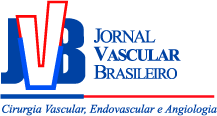Pesquisa sobre escleroterapia líquida em varizes dos membros inferiores
Survey on liquid sclerotherapy of lower limb varicose veins
Marcondes Figueiredo; Matheus Fidelis Figueiredo
Resumo
Palavras-chave
Abstract
Keywords
References
Gloviczki P, Comerota AJ, Dalsing MC. The care of patients with varicose veins and associated chronic venous diseases: Clinical practice guidelines of the Society for Vascular Surgery and the American Venous Forum. J Vasc Surg. 2011;53:2S-48S.
Pinto-Ribeiro A, Medeiros A. Tratamento esclerosante das varizes essenciais: Novos conceitos. J Bras Med. 1967;13:186.
Miyake H, Kauffman P, Behmer AO. Mecanismos das necroses cutâneas provocadas por injeções de esclerosantes no tratamento de microvarizes e telangiectasias. Rev Ass Med Brasil. 1976;22.
Scuderi A, Raskin B, Al Assal F. The incidence of venous disease in Brazil based on the CEAP classification. Int Angiol. 2002;21(4):316-21.
Franscischelli Neto M. Crioescleroterapia. Varizes e Telangiectasias, Diagnóstico e Tratamento. 2005:184-200.
Miyake RK, Zeman HD, Duarte FH. Vein Imaging: A New Method of Near Infrared Imaging, Where a Processed Image Is Projected onto the Skin for the Enhancement of Vein Treatment. Dermatol Surg. 2006;32:1031-1038.
Miyake H, Miyake K, Duarte F, Kikuchi R. Pequenas varizes e telangiectasias. Doenças Vasculares Periféricas. 2008:1769-1795.
Miyake RK, King JT, Kikuchi R, Duarte FH, Davidson JR, Oba C. Role of injection pressure, flow and sclerosant viscosity in causing cutaneous ulceration during sclerotherapy. Phlebology. 2012.
Kabnick LS. Legal guidelines for use of polidocanol and sodium tetradecyl sulfate for sclerotherapy. Foam sclerotherapy: A text book. 2008:43-52.
. .
Tisi PV, Beverley C, Rees A. Tratamiento con inyecciones esclerosantes para las venas varicosas (Revisión Cochrane traducida). La Biblioteca Cochrane Plus. 2008.
Kern P, Ramelet AA, Wütschert R, Hayoz D. Compression after sclerotherapy for telangiectasias and reticular leg veins: a randomized controlled study. J Vasc Surg. 2007;45(6):1212-6.
Mingo JG. Escleroterapia: Como? Cuando? Porque?. 2003:20-28.



